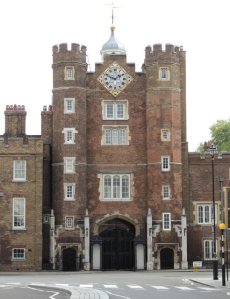One building we can be certain would be completely recognisable to Jane Austen in today’s London is St James’s Palace which lies at the bottom of St James’s Street with Green Park to the north-west and St James’s Park to the south.
It had an unglamorous beginning for a royal palace – as a leper hospital. In the 11th century the parish of St Margaret’s, Westminster (whose church sits in the grounds of Westminster Abbey) was given land for the establishment of a hospital for fourteen leprous women. The hospital was dedicated to St James the Less and was remote from habitation in a swampy area, regularly flooded by a branch of Tyburn Brook. What is now Piccadilly was a track on a ridge leading from the City of London to the west, but it was completely without habitation.
Successive kings and queens granted the hospital money until 1348 when the Black Death seems to have killed off the inhabitants and the buildings were leased out to various occupiers until 1439 when Henry VI granted the hospital and its lands to Eton College. In 1531 Henry VIII took it from the College in a swap with some royal lands elsewhere.
In the City of London and the City of Westminster Henry already possessed the Tower of London, Bridewell Palace, Baynards Castle, Whitehall Palace and Westminster Palace. He had another palace just downstream at Greenwich, plus Hampton Court upstream which he seized from Cardinal Wolsey. Despite all this he decided to build another palace at St James’s and had the old building demolished to make way for it. By acquiring the St James’s property he vastly extended his Westminster/Whitehall lands with a hunting park over a wide area, including what is now St James’s Park.The new palace was begun in 1536 and the great gatehouse that stands at the foot of St James’s Street dates from this phase of building. (Photograph at the top of the page). Edward VI, Mary and Elizabeth all lived at St James’s Palace from time to time and, with the accession of the Stuart dynasty, more work was done to make it a fit residence for the heir. Prince Henry, however, died in 1612, after which it was taken over by his brother, later Charles I. The palace was still remote, with parkland to the south and fields to the north. The only significant development was the Queen’s Chapel, built by Inigo Jones in anticipation of Charles’s marriage to Henrietta Maria, a Roman Catholic who lived at the palace whilst Charles had his base at Whitehall.
During the Commonwealth the palace became a barracks and a prison, but after the Restoration the Duke of York (later James II) used it and considerable building work was carried out. James moved to Whitehall on his accession leaving St James’s to his queen. It was during this period that the palace’s first water closet, ‘The Stool Room’, was built complete with Dutch wall tiles and brass and ivory fittings to operate the flushing cistern.In the years after Charles II’s return to the throne the entire St James’s area was developed and became a major centre for courtiers, hangers-on at the court and the tradesmen who serviced them. After the Glorious Revolution William and Mary did not live at St James’s but Mary’s sister, Queen Anne, did, and had an extensive building programme carried out with a new suite of royal apartments designed by Sir Christopher Wren. The queen held ‘Drawing Rooms’ during the winter months when anyone of respectable appearance would be admitted, along with the courtiers and ministers there to do business, but they were dull occasions and the queen disliked the palace, preferring Windsor Castle or William and Mary’s Kensington Palace.When the Hanoverian monarchs took over the throne in 1714 George I moved into St James’s Palace and used it more intensively than his predecessors. George II disagreed, apparently concurring with the Prussian Baron Bielfeld who called it ‘crazy, smoky and dirty’ and Daniel Defoe who considered it ‘mean’ and beneath the dignity of the court.But it was the official London royal palace – Westminster and Whitehall had become Parliamentary and governmental complexes and the Tower was impossibly medieval. Winter was the time for the court to be in residence there with monarchs preferring Kew, Windsor and Kensington during the summer months.
Prince George, who was to become the Regent, then George IV, was born at St James’s Palace in 1762 and the baby was displayed less than two weeks after his birth to all those attending the Drawing Room. The king and queen considered the palace, described by Sir John Fielding as ‘the jest of foreigners’, to be a ‘dust trap’, so they lived at the Queen’s House (later to become BuckinghamPalace). However that had no state rooms, so the Court was still officially at St James’s – where it remains to this day. All ambassadors are still accredited to The Court of St James’s.
I will visit the Court of St James under George III and George IV, as Regent and king, in my next post.



I’ve only just discovered this new blog of yours, and I’m enjoying it greatly! I never knew about the leper hospital which used to be on this site. And the fact that it was isolated really brings home the fact that even the centre of London was so much smaller, for centuries.
Just so you know – two of the illustrations are not showing up. I can see the palace at the top of the post, but the others just have their descriptions and in the top left SONY DSC
Thanks, HelenaJustina! Don’t know what went wrong with the pictures, but I’ve taken them out for now while I wrestle with it.
I wondered why there weren’t many pictures! hope you get it sorted soon
Pingback: Perambulations Through Late Georgian London or, All the Best Sights in One Week. Day Five | Jane Austen's London